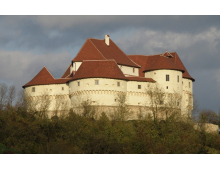North West of Zagreb
- Krapina
- Veliki Tabor
- Kumrovec
- Klanjec
- Pregrada
- Vinagora
A tour of the western Zagorje takes in an undulating landscape of lush green hills, their summits sprinkled with a picture-postcard collection of vineyards, churches and castles.
Krapina
Spread below an attractive ensemble of pudding-shaped hills, the regional capital of Krapina is famous for being the home of Krapina Man, a Neanderthal who lived and hunted here some thirty millennia ago. Prehistoric remains were first discovered at Hušnjakovo just outside town by Dragutin Gorjanović Kramberger in 1899, making Krapina one of the richest Neanderthal sites in Europe. A multi-media display at the excavation site throws fascinating light on Neanderthal lifestyles. Objects found here suggest that they lived in extended family groups and used stone tools to hunt large mammals. Sitting resplendently on
Trški vrh hill over on the opposite side of town, the Church of St Mary is one of the Zagorje’s most popular pilgrimage sites. It was built in 1750 to honour a miracle-working statue of St Mary, brought here from the Holy Land by a local pilgrim in 1669. Surrounded
by a ring of arcades, the church features sumptuous ceiling paintings by Anton Lerchinger, and a splendid collection of altars courtesy of the Austrian sculptor Filip Jakob Straub and the Slovene Anton Mersi.
For more information please visit www.mhz.hr, www.tz-zagorje.hr.
Veliki Tabor
With huge barrel-shaped bastions sprouting skywards from a green ridge, the castle of Veliki Tabor serves as something of a visual trademark for the whole Zagorje region. Built in the early 16th century when the Ottoman threat was at its height, the castle was adapted for residential purposes during more peaceful times, when Renaissance-style arcades were added to the inner courtyard. A museum in the central keep displays artefacts unearthed during the castle’s restoration, alongside fine Renaissance furnishings. Veliki Tabor traditionally hosts the Tabor Film Festival in early July, an annual celebration of independent feature films and shorts.
For more information please visit www.velikitabor.com.
Veronica of Desinić
Visitors to Veliki Tabor are frequently regaled with the 16th century tale of Veronica of Desinić, the local girl who caught the roving eye of young nobleman Friedrich of Celje. Friedrich was already married to a member of the powerful Frankopan family, and his infatuation with Veronica caused consternation on all sides. According to legend, Friedrich’s father Count Hermann of Celje had the couple locked up in separate castles. The unfortunate Veronica was subsequently executed as a witch, and her body was bricked into Veliki Tabor’s walls - where it can still be heard moaning on moonlit nights. In a playfully ghoulish tribute to the tragic heroine, prize-winning films at the Tabor Film Festival receive an award known as ‘Veronica’s Skull’.
For more information please visit www.taborfilmfestival.com.
Kumrovec
One of the Zagorje’s most popular destinations for a family day-out is Kumrovec, a traditional agricultural village whose buildings have been restored to form the “Old Village” Museum (Muzej “Staro selo”). Essentially an open-air ethnographic collection, the museum contains an attractive cluster of nineteenth-century thatched cottages, many of which contain the everyday furnishings and agricultural tools that their former inhabitants would have used. Many of the houses display traditional village crafts, ranging from the embroidered textiles made by Zagorje womenfolk to the brightly coloured gingerbread hearts baked by the village confectioner. Artisans are frequently on hand to demonstrate local crafts, and you can try your own hand on the potter’s wheel.
For more information please visit www.mdc.hr/kumrovec
Josip Broz Tito
Kumrovec is also famous as the birthplace of Josip Broz (1892- 1980), the Croatian communist who – under his adopted party codename of “Tito” – led Yugoslavia’s antifascist resistance movement during World War II and became the founder of the post-war Yugoslav federation. The house where Tito grew up is situated inside the Kumrovec Museum Village and contains mementoes of his career.
Klanjec
Lying in a bowl between hills, the small town of Klanjec spreads below the blackand-white chequered belfry of its seventeenth-century Franciscan church. The church originally served as the mausoleum of the powerful Erdödy family, and a fine pair of Erdödy sarcophagi have been recently restored and put on display in a specially built vault. The burial casket of Emerik Erdödy, mounted on kneeling stags, is one of the most striking examples of Baroque funerary art in Central Europe. Opposite the church is a gallery honouring Klanjecborn sculptor Antun Augustinčić (1900 -1979), who studied in Zagreb and Paris before going on to become one of the most in-demand public artists of the era. Highlight of the exhibition is a cast of the monumental equestrian statue entitled Peace - the original stands outside the United Nations building in New York. Augustinčić himself is buried in the
garden, with a touching sculpture of a wounded soldier marking the spot.
For more information please visit www.klanjec.hr, www.mdc.hr/augustincic.
Pregrada
Nestling beneath hills north of Krapinske Toplice, the small town of Pregrada is dwarfed by the twin towers of its parish church. Often called the “Zagorje Cathedral” due to its large size, the church contains a sonorous organ which was intended for the cathedral in Zagreb but was rejected on the grounds that it wasn’t quite loud enough for a big-city cathedral. Locals pour into town during the last weekend in September for the Branje grozdja (grape harvest), a rural fair featuring folk songs and dances.
For more information please visit www.pregrada.hr.
Vinagora
For one of the best views in the region head for the tiny village of Vinagora just west of Pregrada, where the Pilgrimage Church of St Mary squats picturesquely on a green hill. Originally fortified to withstand enemy attacks and now surrounded by a ring of arcades, the church commands an excellent panorama of the Zagorje’s rippling landscape.
The Croatian National Anthem
Right beside the Terme Tuhelj spa resort is the Mihanović Palace, an eighteenth-century stately home named after the poet and diplomat Antun Mihanović (1796-1861), who - as brother of the lady of the house, Countess Brigljević - was a frequent guest. Mihanović’s love of the Zagorje landscape served as the inspiration behind his Lijepa Naša (“Our Beautiful Homeland”), the song that became Croatia’s National Anthem.





Add a comment
Komentiranje je dopušteno samo registriranim korisnicima. Da biste mogli ostaviti svoj komentar, trebali biste se prijaviti kao registrirani korisnik. Za prijavu koristite link "Prijava korisnika".Ako nemate korisničko ime, molimo vas da se registrirate koristeći link "Registracija korisnika".